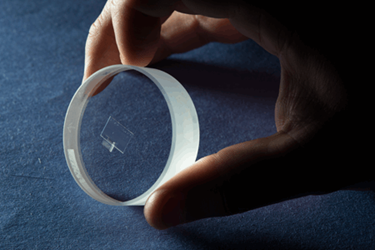Reflecting Light Off Mirrored Cantilevers To Measure Minute Forces
By Jof Enriquez,
Follow me on Twitter @jofenriq

Scientists at the National Institute of Standards and Technology (NIST) Physical Measurement Laboratory (PML) have created optomechanical devices that utilize the momentum of photons to measure seldom-known minute forces.
The first device is a chip-sized sensor made of fused quartz and features a tiny cantilever, less than 1 cm in length. Attached on top of the cantilever is a highly reflective, gold-plated mirror for actuation via radiation pressure. When a light beam hits the mirror, it causes the cantilever to vibrate, akin to a tuning fork. Next to the mirror is a built-in optical cavity that serves as an interferometer. This acts as the motion sensor to measure how far the cavity has moved. The mechanism allows the researchers to calculate the amount of force exerted by the light source.
The penny-sized device can measure forces that are tiny fractions of a newton – from micronewtons (10-6, millionths of a newton) all the way down to 15 femtonewtons (10-15, a million billionth of a newton), at the level of atomic interactions. For comparison, a piconewton (10-12) “will stretch a DNA molecule out,” chemist and research team member Gordon Shaw said in a news release.
Unlike the current “gold standard” method of measuring laser power – a cryogenic radiometer – the chip-based laser power meter like this can be used at room temperature and in real time.
“Most laser power meters work by absorbing the light. After the light goes to the laser power meter, it’s gone,” said Shaw. “With an approach like this, it reflects and you can still use it.”
The PML researchers used low-laser powers, just millionths of a watt, but that amount of light still contains a large number of photons. The researchers hope to build a much more precise device capable of measuring force just by knowing how much force one photon exerts.
According to the news release, the team also experimented with high-power lasers (with powers as high as tens of kilowatts), like those used for industrial applications, such as welding and cutting metals.
For this, they built a tabletop device called the electrostatic force balance (EFB) with similar features to the chip-sized device. However, instead of an interferometer, the EFB "measures electrostatic force generated by a capacitor, whose plates are two concentric cylinders. In vacuum, the researchers reflect a 1-watt laser off the mirror, then measure that force electronically using the capacitor."
Like the smaller device, the EFB's mirror reflects light, which, if modified enough to harness higher-powered lasers, can be used in a laser machining process on a factory floor, claim the researchers.
Commercial applications include sensors that use laser light as a built-in reference, cheap field-portable balances for near-instant measurement of masses of a milligram or less, and compact laser power meters that make real-time measurements.
The study was published in Applied Physics Letters.
